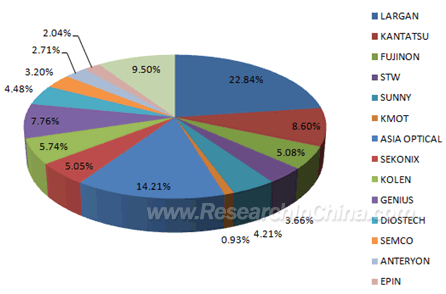|
|
Index>>FreeReport
|
Global and China CMOS Camera Module Industry Report, 2010-2011 (Sample) |
|
2011-07-28 |

|
In 2010, the output value of CMOS camera module increased sharply over 2009, mainly attributable to the following three aspects:
Firstly, the pixel value of mobile phone camera has risen remarkably, and 2-megapixel has become the mainstream. It is expected that 3-megapixel will take the lead in 2011, and 5-megapixel will become the mainstream in 2013.
Secondly, the shipment of smartphone has increased substantially. The camera pixel value of smartphone exceeds 3-megapixel on average, which is far higher than that of ordinary mobile phones.
Thirdly, the all-round promotion of 3G network makes video call possible, bringing a lot of dual-camera mobile phones to the market.
In the field of CMOS sensor in 2010, Omnivision with BSI technology was hailed by Apple and became the exclusive supplier of iPhone. As a result, its shipment and revenue increased substantially, the operating profit increased by more than 15 folds, and its No.1 position in the industry has been further consolidated. In 2011, Apple iPad 2 will adopt dual cameras, and the shipment of iPhone will rise considerably. Apple has ordered all BSI products of Omnivision.
BSI has become a new standard of CMOS sensor. BSI technology was developed by Sony and further promoted by Omnivision through TSMC. Manufacturers like Samsung, SETI and APTINA are following suit. During the technology migration period, the capacity might fall short of the demand, especially in the case of the CMOS sensor for notebook, which makes meager profit and the manufacturers are reluctant to produce. It is expected that the supply of CMOS sensor will be pinched throughout 2011.
In the field of CMOS camera lens, Taiwanese enterprises are becoming stronger despite intensifying competition, while their Japanese counterparts lag behind. Largan Precision has consolidated its dominant position in the industry, way ahead the runner-up, Asia Optical, in revenue. Thanks to Ether Optronics, the mainland-based subsidiary, Asia Optical is getting increased in shipment. Japanese enterprises are engaged in the cut-throat competition with their Taiwanese peers while facing the pressure of JPY appreciation. Most Japanese enterprises are USD10 billion-level giants, and they won’t provide too much support for CMOS camera lens accounting for less than 1% of their revenue. Take KMOT for example, its revenue from CMOS camera lens business in 2010 shrunk to one third of 2009. The same went for Fujinon, and other Japanese enterprises might quit the field.
On the CMOS camera lens market in 2010, Genius Electronic Optical did a great job. In 2005, Genius Electronic Optical was acclaimed because of the glory of Motorola V3 series. In 2006-2009, Genius Electronic Optical suffered hard blows during the consecutive 4 years. But in the second half of 2009, Genius Electronic Optical passed the supplier authentication of Apple, becoming Apple’s second largest supplier of CMOS camera lens. In 2010, the revenue of Genius Electronic Optical rose by nearly 250%. And it is expected that the revenue of the enterprise in 2011 will increase by more than 5 folds over 2009, with the gross margin climbing up to 22% from -3%.
In the field of CMOS camera module assembly in 2010, Foxconn continued to be the leader in this industry. Both Samsung Electro-Mechanics and LG INNOTEK increased their shipment, shoving Sharp from the first place to the third place. With the contracted shipment of Nokia, the shipment of Sharp will decrease further.
Key CMOS Camera Lens Manufacturers by Shipment, 2010  Source: ResearchInChina
For more information, please visit http://www.researchinchina.com/Htmls/Report/2011/6048.html |

|
|
Global and China CMOS Camera Module Industry Report, 2010-2011 (Sample)
|
|